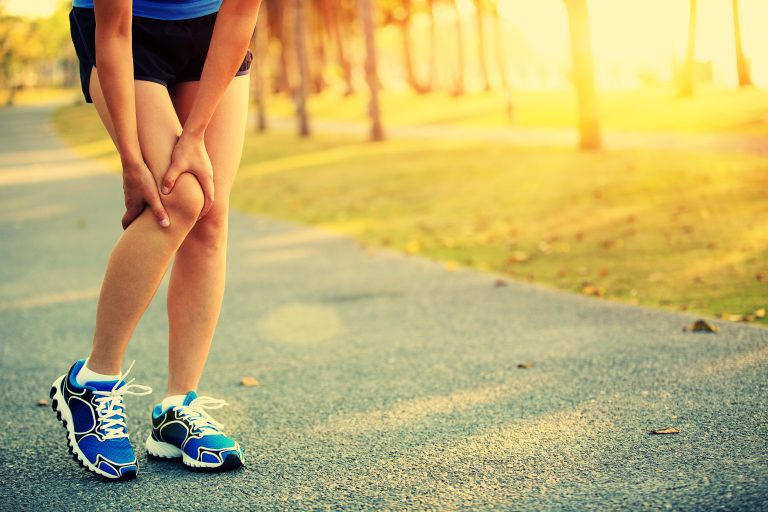DO YOU EXPERIENCE KNEE PAIN OR SNAPPING TO THE OUTSIDE OF YOUR KNEE WHEN YOU RUN?
IS RUNNING DOWNHILL PAINFUL?
If you answered yes to any of these questions, one potential problem may be iliotibial band syndrome.
WHAT IS THE ILIOTIBIAL BAND?
The iliotibial band is a fibrous band of inelastic connective tissue that connects the outside of the hip to just below the outside of the knee. It assists with hip motion and helps stabilize the knee.

WHAT IS ILIOTIBIAL BAND SYNDROME?
Iliotibial band syndrome is a common knee injury among those who participate in activities that require repetitive motion. The band may rub against a bony protrusion on the outside of the femur causing friction and pain. The result is normally experiencing knee pain on outside of knee joint and/or knee snapping.
WHO IS AT RISK FOR ILIOTIBIAL BAND SYNDROME?
Common sports that predispose people to iliotibial band syndrome include running, cycling, hiking, and walking. For runners, running downhill or on uneven surfaces increase the risk of developing iliotibial band syndrome.
HOW CAN YOU TELL IF YOU HAVE ILIOTIBIAL BAND SYNDROME?
Below are several clues to help arrive at that conclusion:
- Pain to the outside of your thigh slightly above the side of your knee.
- Snapping just above the outside of your knee.
- Increasing pain when running, especially downhill.
- Issues with pain when squatting.
- Experiencing pain when bending and straightening knee.
- Tenderness to touch just above the outside of your knee.
HOW DO YOU TREAT ILIOTIBIAL BAND SYNDROME?
The first strategy often attempted to treat this condition is massaging and stretching the iliotibial band. Massage rarely relieves symptoms. Stretching is usually not successful as this structure is not elastic. The muscles it attaches to CAN be stretched but rarely does it resolve the pain. The cause is usually due to poor mechanics and these mechanics need to be fixed!!
HOW DOES A RUNNER GET RID OF ILIOTIBIAL BAND SYNDROME?
There is often a problem either above or below the knee that causes the pain. You just need to figure out what that is. Start by looking at these things:
- Muscle weakness
- Shoe wear
- Running mechanics
MUSCLE WEAKNESS:
A very common cause of iliotibial band syndrome is hip weakness. The two primary glute muscles critical for healthy running include:
- Gluteus medius – is located on the outside of your hip and its primary function is to keep your hips/pelvis level when standing on one leg. When weak, your non-weight bearing hip may “drop”. For example, with right gluteus medius weakness, your left hip will drop when you weight bear through your right leg. When this occurs, the iliotibial band on the weight bearing leg will be compressed right above the knee.

- Gluteus maximus– this muscle is very important to prevent the knee from caving in. For example, with right gluteus maximus weakness, the right knee will cave in when weight bearing on the right side, causing stress to the iliotibial band.

Here are some strengthening exercises helpful to improve glute strength and move you towards pain free exercise.
- Bridging, Side leg lifts, Clams, Squats
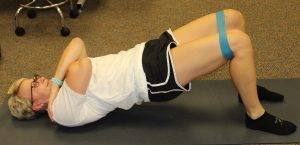
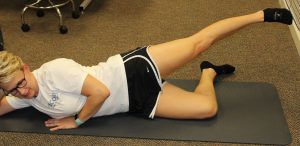
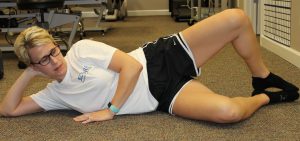
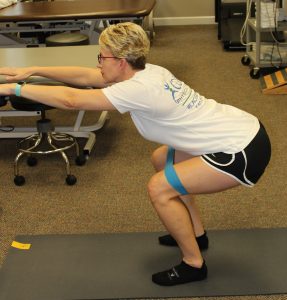
Top Left: Bridging; Top Right: Side Leg Lifts; Middle: Clams; Bottom Bottom: Squat
Let’s go over how to perform each exercise:
- Bridging: Lift your butt while contracting your butt muscles. Keep your pelvis level. Do not overuse your hamstrings (muscles in the back of your thigh).
- If you experience cramping to the back of your thigh, it is because you are using your hamstrings too much and not using your butt enough.
- Concentrate on squeezing those “cheeks”! If you add an elastic band around your knees (as pictured), that will increase the difficulty.
- You may also be able to do a one leg bridge by lifting one leg in the air and performing the exercise with the other leg. This greatly increases the difficulty. This is a good exercise to engage your butt without hurting your knee.
- Side leg lifts: This exercise works the butt muscle that is responsible for keeping your pelvis level when you stand on one leg. It is critically important when you run to have strength in this muscle to support your body weight on that leg. When you perform this exercise, be sure to keep your thigh in line with your trunk or slightly behind. Do not let your leg migrate forward. Keep your knee straight.
- Clams: This also works your butt muscles. Work on moving your hip joint only. Do not let your pelvis roll back. If it is too easy, add an elastic band around your knees.
- Squat: This is an excellent exercise for the butt. However, if done improperly, it can cause knee pain. If this is new for you, a mirror or a friend who is comfortable with proper squatting technique may be helpful to give you proper cues.
- There are a lot of things to think about when performing the squat. First, pivot at your hips (stick your butt out) and then sit back as if you are sitting on a chair. Keep your back straight (don’t let it round). Keep your weight through your heels so your knees do move too far forward. Do not let your knees cave in toward one another.
- An elastic band around the knees will help kick in the butt muscles especially for those who have trouble keeping their knees apart.
SHOE WEAR:
As mentioned above, the cause of iliotibial band syndrome is often due to mechanical problems above or below the knee. Shoe wear may need to be changed to reduce pain.
- If your foot is flexible, look for a shoe that provides stability to prevent your foot from rolling in excessively. Your foot rolling in may subsequently cause your knee to roll in causing stress to your iliotibial band.
- For folks who have a rigid foot, choose a shoe that offers cushion to allow for better shock absorption at impact. To learn more about foot structure, check out this article on anterior knee pain. (can we put the article info here?)
RUNNING MECHANICS:
Running mechanics are likely the cause of your iliotibial band syndrome. Common running errors include:
- Hip drop
- Knee cave in
- Cross over midline
HIP DROP
Hip drop when weight bearing on the injured leg may be the cause of your pain. Strengthen those glutes!! If you feel they are strong, work on preventing hip drop as it may be a motor control problem rather than true glute weakness.
KNEE CAVE IN
Knee cave in may be due to glute weakness or a motor control problem. Strengthen! If that doesn’t help, work on preventing your knee from caving in by contracting your glutes when weight bearing on the injured side or check your shoes to be sure they are not contributing to the problem.
CROSS OVER MIDLINE
If your feet cross over the midline of your body when running, this may cause compression and stress to the iliotibial band. To assess, go to a track and straddle one of the white lines. Run with the line in between your feet. If your feet cross the line, work on running with your feet on either side of the white line and do not cross over.
ARE THERE OTHER CAUSES FOR KNEE PAIN?
Above are the more common causes of iliotibial band syndrome but there may be other reasons for your pain. If the pain persists despite your efforts, contact a physical therapist trained in treating those with running injuries. Videotape analysis is invaluable. Find someone skilled in running analysis. This problem can often be resolved quickly with the appropriate treatment. Good luck!!

